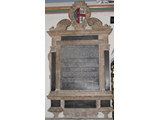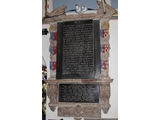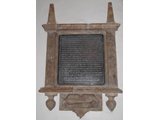Lords of the Manor - The Myllets and Lanes
The first notable Lord of the Manor of Perivale was Geoffrey de Mandeville, a powerful Norman Baron who came to England with William the Conqueror and was rewarded with 118 Lordships or manors, including Greenford Parva (later Perivale). Subsequently the manor was inherited through his descendants for the next 230 years, and it seems highly likely that one of them built the church. In the early 14th century, the advowson passed to Edward II who passed it on to Walter Langton in 1307. Thereafter it passed through various hands, including Sir Henry de Beaumont (1313), and descendants, until Thomas Charlton bought it in 1387. From thence it passed through Henry Collet in 1490 to Sir Humphrey Brown in 1521, and his grandson, Roger Townsend, sold the manor to Henry Myllet in 1566.
The Myllet family is forever associated with Perivale because of the Myllet brass – and the Myllet Arms! However the Henry Myllet commemorated in the brass (with his 2 wives and 15 children) died in 1500, whereas his descendant Henry Myllet (presumably his grandson) only purchased the manor in 1566 from Roger Townsend. He had been churchwarden there in 1554. Thereafter, the Myllet family and their descendants on the female side – the Lanes and Harrisons – were Lords of the Manor for two centuries. They are particularly interesting because of the fine memorials to some of them in the chancel. Henry's son, George, inherited the estate and title in 1587, and died before 1600. There was previously a brass in the chancel dedicated to his memory, but this was lost in the Victorian Restoration. He married Joan Pitts (1566-1623), who then married John Shelbury after George's death, and is commemorated by the oldest wall memorial in the church (to 'Joan Shelbury'), dating from 1623, in which she describes her first husband as ‘Lord of this Towne'.
Their daughter, Elizabeth, married John Lane, died in 1655, and also has a fine memorial. Thereafter the Patronage passed to Thomas Lane, (1582-1652), the brother of John, who is commemorated by another fine memorial in the chancel. He was an eminent lawyer and politician who was called to the bar in 1610, and an MP for Wycombe at various times between 1625 and 1648, in the troubled period of conflict between the Parliament and King Charles I. He supported the parliamentary cause, but was ejected under 'Pride's Purge' in 1648. He presumably witnessed the execution of the king in 1649. He died in 1652 and was buried in the church.
Previous .......................................................Point mouse to enlarge any image......................................................Next
Home
| Events Archive | Musicians | History | Pictures
| Video | Friends
| Contact Us
Search
 Memorial to Elizabeth Lane, died 1655, daughter of George and Jane Millet
Memorial to Elizabeth Lane, died 1655, daughter of George and Jane Millet  Memorial to Thomas Lane 1582-1652, brother-in-law of Elizabeth Millet
Memorial to Thomas Lane 1582-1652, brother-in-law of Elizabeth Millet Memorial to Joan Shelbury, wife of George Millet, died 1623
Memorial to Joan Shelbury, wife of George Millet, died 1623